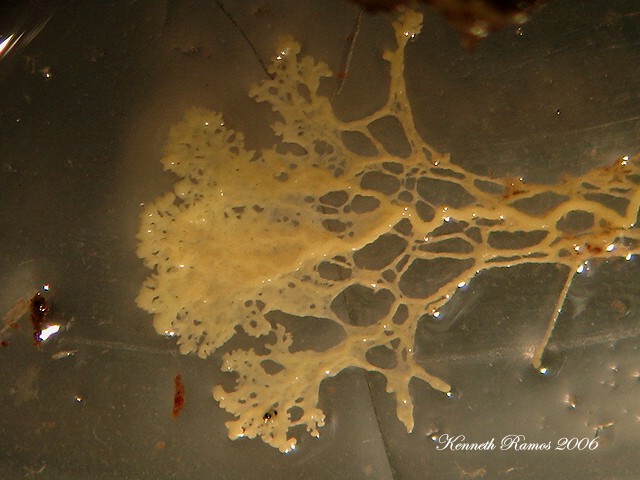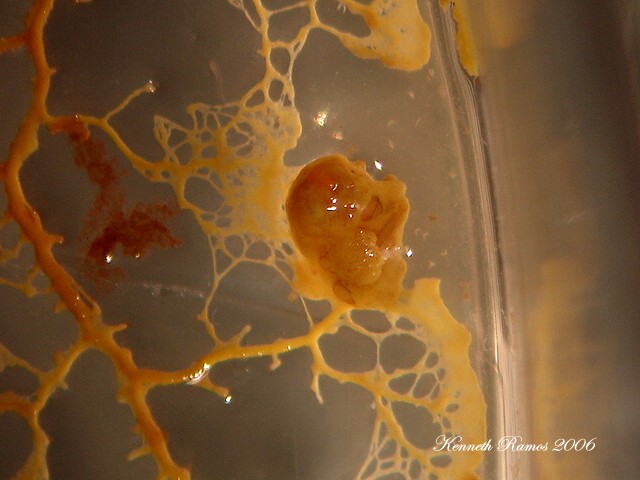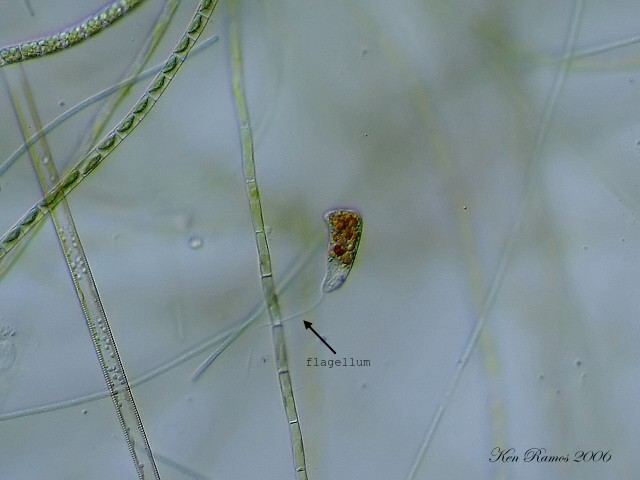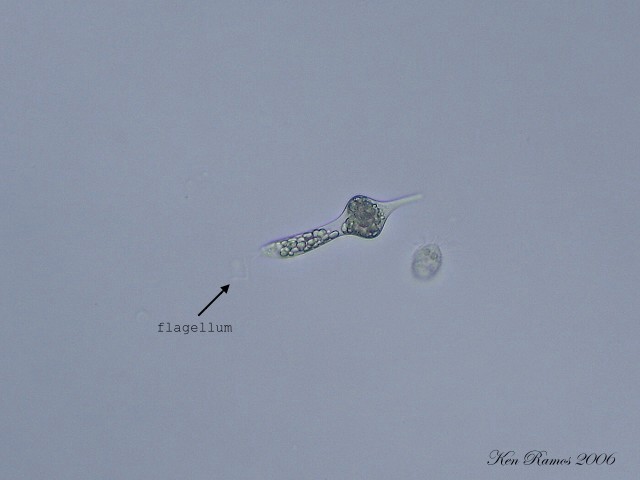Biology Forum › Microbiology › Behaviour of Amoebozoans
- AuthorPosts
- March 10, 2006 at 12:24 am #3968
 bionewbieParticipant
bionewbieParticipantWhy would excess water tend to accumulate in the Amoeba?
- March 10, 2006 at 3:18 am #42936
 kiekyonParticipant
kiekyonParticipantthe concentration in amoeba is higher than the concentration in water.
therefore water tend to enter through osmosis - March 10, 2006 at 3:32 am #42942
 bionewbieParticipant
bionewbieParticipantthe answer sounds almost too simple …
On a separate note but keeping on the topic of amoebas, how would one expect the movement to differ between Trypanosoma & Amoeba?
- March 10, 2006 at 7:39 am #42966
 kiekyonParticipantquote bionewbie:the answer sounds almost too simple …
kiekyonParticipantquote bionewbie:the answer sounds almost too simple …that’s because it’s a simple question
- March 10, 2006 at 1:10 pm #42973
 Ken RamosParticipant
Ken RamosParticipantbionewbie asks:
quote :On a separate note but keeping on the topic of amoebas, how would one expect the movement to differ between Trypanosoma & Amoeba?Trypanosomes are flagellates belonging to the Phylum Mastigophora. Their primary means of locomotion is by the use of a whip-like extention known as a flagellum. This organell moves somewhat like a screw, drawing the organism along through what ever liquid medium it is found in. Amoebae on the otherhand move by means of their pseudopodia or "false feet." This is known as "amoeboid movement," which is not too uncommon in some other microorganisms. The amoeba makes a protoplasmic extention of itself and the rest of the cell flows into that extension to but it simply. Although movement by eruptive waves of protoplasm maybe the primary mode of locomotion for amoebae, there are some which do have flagella. These are known as amoebo-flagellates, most commonly found in myxomycota. 😀
- March 10, 2006 at 3:55 pm #42978
 bionewbieParticipant
bionewbieParticipantBut what happens with the movement of Amoeba & Physarum? Aren’t they both part of the Amoebozoans?
- March 10, 2006 at 11:29 pm #42990
 Ken RamosParticipant
Ken RamosParticipantbionewbe asks:
quote :But what happens with the movement of Amoeba & Physarum? Aren’t they both part of the Amoebozoans?Are you referring to Physarum as in Mycetozoia? If so, yes they are both part of the group of organisms we call amoebae. The amoebae associated with Myxomycetes, Mycetozoia, or Myxomycota; which ever taxia in which you wish to place them, there is still great debates over that between zoologists and botonists, have the ability to transition from the amoebo-flagellate form of locomotion to the amoeboid form of locomotion. There are also some other forms of amoebo-flagellates that are not associated with Mycetozoia, if I am not mistaken. However Physarum viride, didermoides and polycephalum are all part of the Phylum Sarcodina, Subphylum Hydraula, Superorder Acraseda, Class Alternatea, Subclass Mycetozoia, Order Physarida. (Ref: Jahns, How to Know the Protozoa, Second Edition, McGraw Hill Publishing) 😀
- March 11, 2006 at 1:24 am #42996
 bionewbieParticipantquote Ken Ramos:Are you referring to Physarum as in Mycetozoia?
bionewbieParticipantquote Ken Ramos:Are you referring to Physarum as in Mycetozoia?Well I mean Physarum as in a plasmoidal slime mold. All I know is that they stream along as plasmodiums. So I’m just wondering how their movement is similar / different from Amoebas.
- March 11, 2006 at 2:19 am #42997
 Ken RamosParticipant
Ken RamosParticipantbionewbe asked:
quote :Well I mean Physarum as in a plasmoidal slime mold. All I know is that they stream along as plasmodiums. So I’m just wondering how their movement is similar / different from AmoebasOh, o.k. I see what you mean. Sorry for the misunderstanding. 😳 Actually there is not much if any difference in the streaming movements of microscopic amoebae and the plasmodium of myxomycetes. Both move by what is termed amoeboid movement, in which the pseudopodium is extended and the remaining protoplasm flows into it. The plasmodium is nothing more than thousands if not more amoebae or amoebo-flagellates fused together to make one giant multinucleate amoeba. So when you see a plasmodium you are actually seeing a single multinucleate cell, an amoeba. 😮
If you will click on the attached image of the plasmodium I have here, you can see that it also has a multitude of pseudopodia and it uses its psuedopodia much the same way as do other amoebae. Even when the plasmodium feeds, it does so by phagocytosis, the engulfing of its prey or food and then surrounding it with digestive enzymes. 😀
- March 11, 2006 at 2:31 am #42998
 Ken RamosParticipant
Ken RamosParticipant - March 11, 2006 at 3:20 am #43002
 bionewbieParticipantquote Ken Ramos:bionewbe asked:quote :Well I mean Physarum as in a plasmoidal slime mold. All I know is that they stream along as plasmodiums. So I’m just wondering how their movement is similar / different from Amoebas
bionewbieParticipantquote Ken Ramos:bionewbe asked:quote :Well I mean Physarum as in a plasmoidal slime mold. All I know is that they stream along as plasmodiums. So I’m just wondering how their movement is similar / different from AmoebasOh, o.k. I see what you mean. Sorry for the misunderstanding.
No worries! Actually what you said was really useful. btw, your pictures were so cool!
quote Ken Ramos:Actually there is not much if any difference in the streaming movements of microscopic amoebae and the plasmodium of myxomycetes. Both move by what is termed amoeboid movement, in which the pseudopodium is extended and the remaining protoplasm flows into it. The plasmodium is nothing more than thousands if not more amoebae or amoebo-flagellates fused together to make one giant multinucleate amoeba. So when you see a plasmodium you are actually seeing a single multinucleate cell, an amoeba. 😮So, if the movements are similar, then what are the functions for the cytoplasmic movement of Physarum?
- March 11, 2006 at 10:52 am #43012
 Ken RamosParticipant
Ken RamosParticipantbionewbe asked:
quote :So, if the movements are similar, then what are the functions for the cytoplasmic movement of Physarum?A very good question you have asked here. 😀 To my understanding that has yet to be sufficently answered by biologist and protozoologist. Amoeboid movement or cytoplasmic streaming has yet to be fully understood, however there are many theories as to how it all comes about.
I refered to the protoplasmic extentions of the plasmodium as pseudopodia, I do believe I was wrong in that terminology. In Jahns book they are refered to as "myxopodia," which seems to be a more correct and descriptive term and are described as polytubular networks formed from oscillating streams of cytoplasm and are at the advancing margin of the "mycetozoan." Again terminology for these species is quite diverse. I would have refered to the mycetozoan as a plasmodium but I think that mycetozaon is a more collective term. 😀
I wish that I could give you a better answer to your question but information on that subject is quite diverse and scattered. So, it is to my assumption, if I have not misunderstood your question, that the function of movement is much or exactly the same as what occurs with its microscopic counterparts and the cause of the cytoplasmic streaming or amoebiod movement is still being debated. There maybe someone else who is following this post, that may be able to shed a little light on the subject and I would be interested too in reading what they have to say but still it would not be given to absolute fact, as far as I know; because at my last reading, it was still being debated by biologists and protozoologist. 😀
OBTW, thanks for your comment on the photographs. If you are interested go to my web page for a view of the set up used to take those photographs. The microscope is shown in the first photograph on the front page. Just click on the www icon at the bottom of my signature below on this page. 😀
- March 11, 2006 at 10:25 pm #43055
 bionewbieParticipant
bionewbieParticipantSo now, say I compare the movement of Paramecium and Amoeba … I know that there are obviously differences since the Paramecium is a ciliate whereas Amobea isn’t.
- March 12, 2006 at 12:31 am #43066
 Ken RamosParticipant
Ken RamosParticipantAbout the only good comparison we could do, is that of efficency in locomotion. Obviously thousands of beating cilia are more efficent than say one flagellum, some flagellates have two flagella but one is usually trailing and the other employed for locomotion. While as for a pseudopodium, putting one foot forward and dragging the rest along really doesn’t get you anywhere quickly. Ciliates are the fastest and most difficult of the protozoa to follow in observation without adding some sort of medium to thicken the water or medium that they are in. Usually a small amount of a cellulose based paste will slow them down enough to get a really good look at them. 😀
A word of note or trivia, on average the plasmodium of the myxomycete moves at about one inch per hour using its pseudopdia. 😮
BTW another comparison to paramecium and the amoeba is that of feeding. The paramecium uses its cilia to draw in or collect food in the oral groove to ingest into the gullet, where as the amoeba uses its pseudopodia to surround and engulf (phagocytosis) its food. There maybe a number of other comparisons to be made if one would think about it. 😀
- March 12, 2006 at 4:17 am #43070
 bionewbieParticipant
bionewbieParticipantSince flagella will guide the organism as it moves … but Paramecium is lined with cilia, so does the Paramecium rotate at all as it moves?
Same question goes with Amoeba … does it rotate at all? or does it simply extend its pseudopod in the direction that it needs to go, so it’s not really ‘rotation’ in the traditional sense [I do hope this make sense!]
- March 12, 2006 at 1:11 pm #43084
 Ken RamosParticipant
Ken RamosParticipantYes there is rotation in the paramecium as it swims along, due to the beat of the cilia which covers its body or covers the cell, maybe I should say. At any case it does rotate as it swims. The amoeba on the other hand, flows slowly along its path. However you may find this interesting in the amoeba Chaos carolinense, it will sometimes "walk" on the substratum that it may be on! 😮 This is accomplished by raising itself upon its pseudopodia and then extending one forward after another. These are quite large for ameobae since there size can reach anywhere from 1-5mm, makeing them visible to the naked eye and amazing to observe through the microscope. 😀
- March 12, 2006 at 8:12 pm #43098
 bionewbieParticipantquote Ken Ramos:These are quite large for ameobae since there size can reach anywhere from 1-5mm, makeing them visible to the naked eye and amazing to observe through the microscope. 😀
bionewbieParticipantquote Ken Ramos:These are quite large for ameobae since there size can reach anywhere from 1-5mm, makeing them visible to the naked eye and amazing to observe through the microscope. 😀So, relative to an Amoeba, how large is the trypanosome?
- March 12, 2006 at 8:23 pm #43099
 bionewbieParticipantquote Ken Ramos:About the only good comparison we could do, is that of efficency in locomotion. Obviously thousands of beating cilia are more efficent than say one flagellum, some flagellates have two flagella but one is usually trailing and the other employed for locomotion.
bionewbieParticipantquote Ken Ramos:About the only good comparison we could do, is that of efficency in locomotion. Obviously thousands of beating cilia are more efficent than say one flagellum, some flagellates have two flagella but one is usually trailing and the other employed for locomotion.I forgot to comment, you said that some organisms have two flagella, so that’s like an Euglena, right?
- March 12, 2006 at 9:00 pm #43104
 Ken RamosParticipant
Ken RamosParticipantbionewbe asked:
quote :So, relative to an Amoeba, how large is the trypanosome?On average I would venture to say about one half the size of most, not all, amoebae. Most of the trypanosmes I have listed are in the range of 25 microns up to about 65 microns (um). As for the amoeba, some are as small as 4um ranging in size up to 600um, with the exception of Chaos carolinesis which can be from 1-5mm in size. Most of the amoeba normally encounted by myself now, are from 80um up to about 230um. That is where I am getting my size average in relation to the trypanosomes. Sizes of micro organisms are so varied by species, that to say one is relatively larger than the next or smaller than the next on average, would be in my opinion be difficult to say. 🙄
bionewbe also asked:
quote :I forgot to comment, you said that some organisms have two flagella, so that’s like an Euglena, right?Well I do not know of any Euglena that have two flagellums but that is not to say that there are not any. Just that I do not know of any Euglena with two. Now there are other flagellated protozoans which do have two flagella but one is usually trailing and not employed in swimming as is the other. 😀
- March 13, 2006 at 12:57 am #43111
 bionewbieParticipantquote Ken Ramos:Well I do not know of any Euglena that have two flagellums but that is not to say that there are not any. Just that I do not know of any Euglena with two. Now there are other flagellated protozoans which do have two flagella but one is usually trailing and not employed in swimming as is the other. 😀
bionewbieParticipantquote Ken Ramos:Well I do not know of any Euglena that have two flagellums but that is not to say that there are not any. Just that I do not know of any Euglena with two. Now there are other flagellated protozoans which do have two flagella but one is usually trailing and not employed in swimming as is the other. 😀I hope that I didn’t confuse you when I mentioned Englenas – which I associate with Euglenids which is one of the flagellate groups. I’m just wonderng what kind of movements can be observed in Euglenas …
- March 13, 2006 at 2:30 am #43115
 Ken RamosParticipant
Ken RamosParticipantTheir movements are about as fast as ciliates, the flagellum can be seen extended in front of the eulgena and the tip moving about somewhat like a small propeller or screw. The entire flagellum does not move, only the tip of it while swimming. When changing extreme directions the whole flagellum will bend but still only the tip is propelling or pulling the euglena through the water. Cilia on the otherhand are more like tiny oars. 😀
At present I have no photographs of Euglena but I do have a couple flagellates to show you. The flagellum is marked by an arrow in both images and they are quite hard to see, so look closely. Both of these organisms can alter the shape of their bodies as they change directions or casually move about. This is especially noted in Distigma proteus 😀
Click on image for larger view pls. 😮
- March 13, 2006 at 2:36 am #43116
 Ken RamosParticipant
Ken RamosParticipantBy the way I forgot to note that Distigma proteus has two flagella (the shorter one not shown in the photograph) and does use both for swimming. Usually one flagellum trails along but not in the case of this organism. Jahns book, "How to Know the Protozoa" states: "the longer flagellum moves with a complicated spiral wave, the shorter one with a full length latero-posterior stroke." 😀
- March 13, 2006 at 3:22 am #43123
 bionewbieParticipantquote Ken Ramos:Their movements are about as fast as ciliates, the flagellum can be seen extended in front of the euglena and the tip moving about somewhat like a small propeller or screw. The entire flagellum does not move, only the tip of it while swimming. When changing extreme directions the whole flagellum will bend but still only the tip is propelling or pulling the euglena through the water. Cilia on the otherhand are more like tiny oars.
bionewbieParticipantquote Ken Ramos:Their movements are about as fast as ciliates, the flagellum can be seen extended in front of the euglena and the tip moving about somewhat like a small propeller or screw. The entire flagellum does not move, only the tip of it while swimming. When changing extreme directions the whole flagellum will bend but still only the tip is propelling or pulling the euglena through the water. Cilia on the otherhand are more like tiny oars.So, would the movements of a flagellum be smooth or "jerky"? or will it different depending on the organism itself?
- March 13, 2006 at 10:36 am #43134
 Ken RamosParticipant
Ken RamosParticipantbionewbe asked:
quote :So, would the movements of a flagellum be smooth or “jerky”? or will it different depending on the organism itself?I will go as far as to say that in my observations of flagellates, it would depend on the organism itself. The Peranema for example moves in a smooth, steady path while swimming; whereas some smaller flagellates seem to jump around, such as Chilomonas paramecium (not to be conufused with the ciliate paramecium). C. paramecium is quite small, about 40um and has two flagella with numerous small chloroplasts and one water expelling vesicle (wev). They are usually found in putrid plant infusions. 😀
- March 13, 2006 at 12:25 pm #43137
 bionewbieParticipantquote Ken Ramos:I will go as far as to say that in my observations of flagellates, it would depend on the organism itself. The Peranema for example moves in a smooth, steady path while swimming; whereas some smaller flagellates seem to jump around, such as Chilomonas paramecium (not to be conufused with the ciliate paramecium). C. paramecium is quite small, about 40um and has two flagella with numerous small chloroplasts and one water expelling vesicle (wev). They are usually found in putrid plant infusions. 😀
bionewbieParticipantquote Ken Ramos:I will go as far as to say that in my observations of flagellates, it would depend on the organism itself. The Peranema for example moves in a smooth, steady path while swimming; whereas some smaller flagellates seem to jump around, such as Chilomonas paramecium (not to be conufused with the ciliate paramecium). C. paramecium is quite small, about 40um and has two flagella with numerous small chloroplasts and one water expelling vesicle (wev). They are usually found in putrid plant infusions. 😀We already noted the fact that some organism simply glide through the medium, while others have guided by two flagella (one for direction and the other for locotion. What about other genus of species, say for example the Green Algae where certain organisms (e.g. Chlamydomonas) have flagella than comparing that with the flagellates … is there some sort of generalization in terms of the movement?
- March 14, 2006 at 12:33 am #43193
 Ken RamosParticipantquote :… is there some sort of generalization in terms of the movement?
Ken RamosParticipantquote :… is there some sort of generalization in terms of the movement?Most biology text books will give a basic generalization of flagellar movement but I would not attempt to place one myself. The number of species of flagellates are so large and every form of flagellar locomotion so diverse, I really do not see how we could generalize flagellar locomotion other than to say that, "locomotion is accomplished by a whip-like extention of the organism called a flagellum." Flagellated algaes are extremely diverse also in there forms of movement and it still has not been settled if they are actually plants or animals because they exhibit the characteristics of both. 😀
- March 14, 2006 at 3:06 am #43212
 bionewbieParticipantquote Ken Ramos:quote :… is there some sort of generalization in terms of the movement?
bionewbieParticipantquote Ken Ramos:quote :… is there some sort of generalization in terms of the movement?Most biology text books will give a basic generalization of flagellar movement but I would not attempt to place one myself. The number of species of flagellates are so large and every form of flagellar locomotion so diverse, I really do not see how we could generalize flagellar locomotion other than to say that, “locomotion is accomplished by a whip-like extention of the organism called a flagellum.” Flagellated algaes are extremely diverse also in there forms of movement and it still has not been settled if they are actually plants or animals because they exhibit the characteristics of both. 😀
lol I guess it all comes back to diversity and the fact that we can’t really stick everything into some defined group … anyways, I really appreciate all your help on this thread.
- March 14, 2006 at 10:48 am #43242
 Ken RamosParticipant
Ken RamosParticipantbionewbe wrote:
quote :I guess it all comes back to diversity and the fact that we can’t really stick everything into some defined groupIt is probably a good thing that we can’t place everything into some defined group, we would probably loose interest in them. Look at protozoa, some exhibit the characteristics of animals, others that of animals and plants. Since no one can decide where protozoa should be classed, they have given them their own kingdom. Protista. Yet with their own kingdom, they are so diverse in species, over 50,000 known species with more being discovered every day, we may never fully understand them. 😉
- July 12, 2011 at 11:51 am #105567
 sara135Participant
sara135ParticipantFrom comparative analysis of EST data for five taxa within the eukaryotic supergroup Amoebozoa, including two free-living amoebae (Acanthamoeba castellanii, Hartmannella vermiformis) and three slime molds (Physarum polycephalum, Hyperamoeba dachnaya and Hyperamoeba sp.), we obtained new broad-range perspectives on the evolution and biosynthetic capacity of this assemblage. Together with genome sequences for the amoebozoans Dictyostelium discoideum and Entamoeba histolytica, and including partial genome sequence available for A. castellanii, we used the EST data to identify genes that appear to be exclusive to the supergroup, and to specific clades therein. Many of these genes are likely involved in cell–cell communication or differentiation. In examining on a broad scale a number of characters that previously have been considered in simpler cross-species comparisons, typically between Dictyostelium and Entamoeba, we find that Amoebozoa as a whole exhibits striking variation in the number and distribution of biosynthetic pathways, for example, ones for certain critical stress-response molecules, including trehalose and mannitol. Finally, we report additional compelling cases of lateral gene transfer within Amoebozoa, further emphasizing that although this process has influenced genome evolution in all examined amoebozoan taxa, it has done so to a variable extent.
- AuthorPosts
You must be logged in to reply to this topic.



